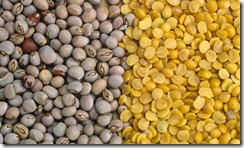If more small farmers in Africa’s drought-prone regions grew improved varieties of dryland crops, their communities would be better prepared for prolonged dry spells and scarce rain
As the world considers long-term solutions to mitigate the impact of the next drought, drought-resistant crops are often mentioned as part of the solution.
The concept has been around for years. In 2000, a UN taskforce on food security in the Horn of Africa highlighted the need for farmers to adopt drought-tolerant crop varieties. The Food and Agriculture Organisation talks about improving dryland crop production to build resilience, so the issue is to turn these ideas into reality.
Farmers traditionally cultivate these crops on part of their fields to feed their families: millet, sorghum, pigeonpea, chickpea, cowpea, beans etc. But yields are often low, partly due to lack of access to better seeds. If more smallholder farmers in drought-prone regions grew improved varieties of dryland crops, their communities would be better prepared for prolonged dry spells and scarce rain. The challenge is to get these seeds to farmers and encourage their use.
Eunice Makenga could be part of the answer. She runs a small shop in Kenya’s Nzaui district selling seeds, fertilisers and pesticides. One of only a few agro-dealers to sell improved drought-tolerant seeds, she buys small "trial packs" from Leldet farm in Nakuru – where Janey Leakey runs the first seed business to focus on these "neglected crops".
Leakey has been working with researchers from the International Crop Research Centre for the Semi-Arid Tropics (Icrisat) as well as the Kenya Agriculture Research Institute to develop and distribute higher-yielding and more drought- and pest-resistant crop varieties. For instance, improved pigeonpea varieties have produced an average 38% rise in harvests, Icrisat’s research shows, while improved groundnut and chickpea varieties have increased harvests by 59% and 33% respectively.
The Alliance for a Green Revolution in Africa has supported Leakey in marketing these trial packs to farmers, particularly women, who are eager to tackle hunger and malnutrition in their households. Women have less access to improved seeds, and making these as affordable as a cup of tea is crucial.
The problem is lack of demand. Farmers in the region mostly focus on growing marketable crops such as maize that suffer in dry areas. Leakey tries to encourage them to diversify by offering the "Leldet bouquet": instead of 2kg of maize seeds costing 300 Kenyan shillings ($3), the farmer can get a mix of five seed packets with an equivalent weight of cowpeas, sorghum, beans, pigeonpea, millet and maize. The mix of crops is adapted to the farmer’s location.
To make a real difference, though, governments have to weigh in. They could do more to encourage farmers to grow these crops on a larger scale through measures that create a market for them. Governments should make it easier to get new varieties certified and on to the shelves of agro-dealers, develop the local seed industry for improved dryland crop varieties, and give dryland crops a market value. Regional harmonisation on certification would be another useful step, so that once an improved variety is certified in one country it is also certified for other countries in the region.
But farmers must be convinced that these crops will bring a good return if they are to buy them.
Millions of dollars of seed aid will be distributed in response to the Horn of Africa drought. Why not source these seeds locally and use this as a way to create long-term demand for high-yielding, drought-tolerant crops?
In Malawi, Irish Aid works with Icrisat to train local seed breeders to produce improved groundnut and pigeonpea seeds that the government buys and distributes to farmers as seed subsidies. It is a national seed-aid approach that creates local jobs, introduces better varieties and provides an incentive to grow the seeds.
Including more crops such as sorghum and millet in national strategic grain reserves could be an immediate step to boost dryland crop value. If the Kenyan government were to order thousands of tonnes of sorghum and other drought-resistant crops to fill its strategic grain reserve shops, farmers would see these crops in a new light because there would be a market for them. They would want to buy such seeds for the next planting season – and if rains are scarce early next year, these farmers would still reap a harvest and manage to escape the drought trap.


Deprecated: strpos(): Passing null to parameter #1 ($haystack) of type string is deprecated in /home/agriviek8Qv/agriviet.net/public_html/wp-includes/comment-template.php on line 2522